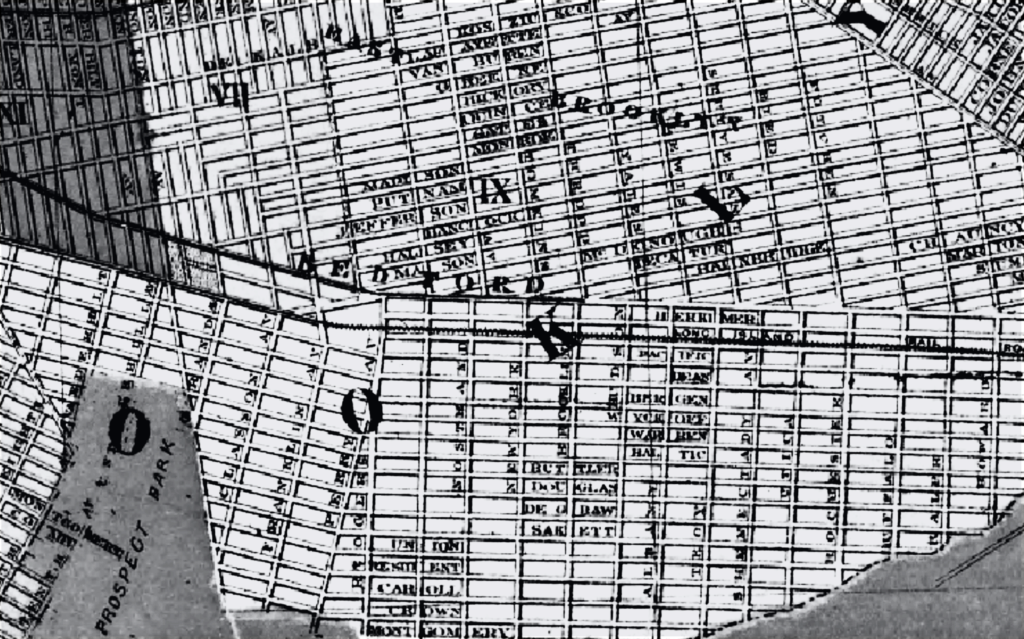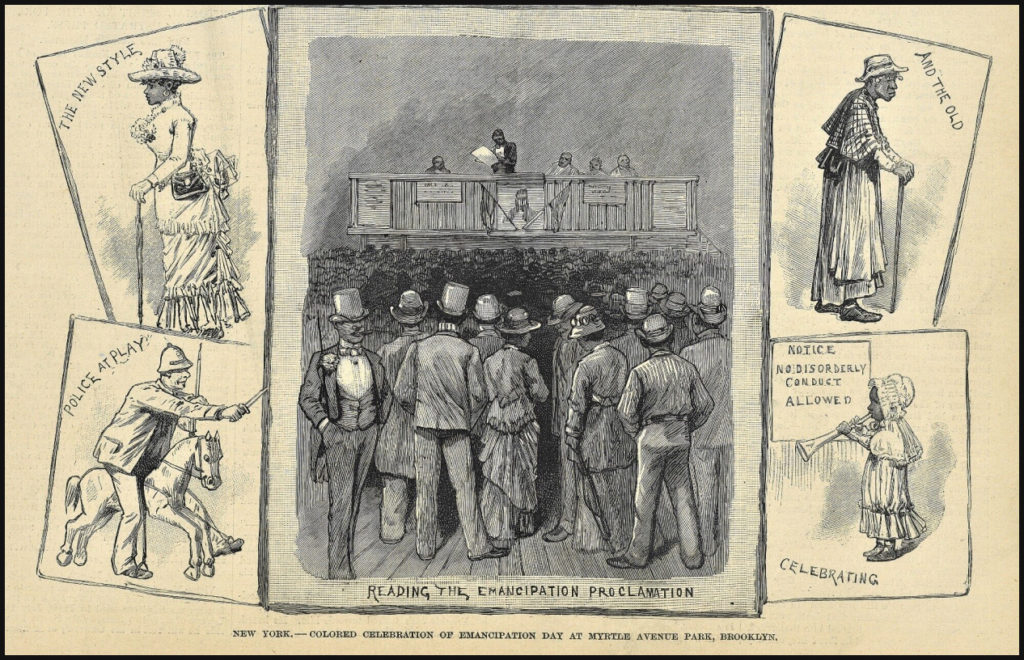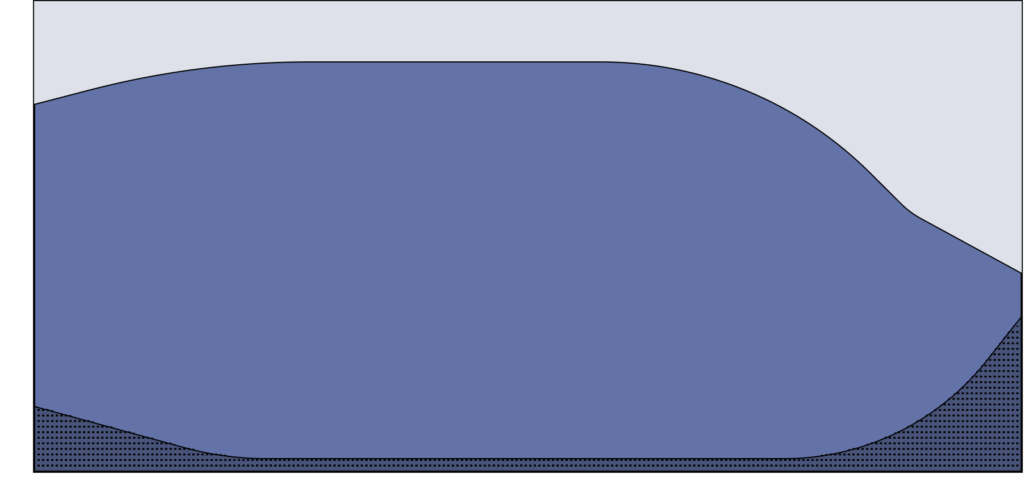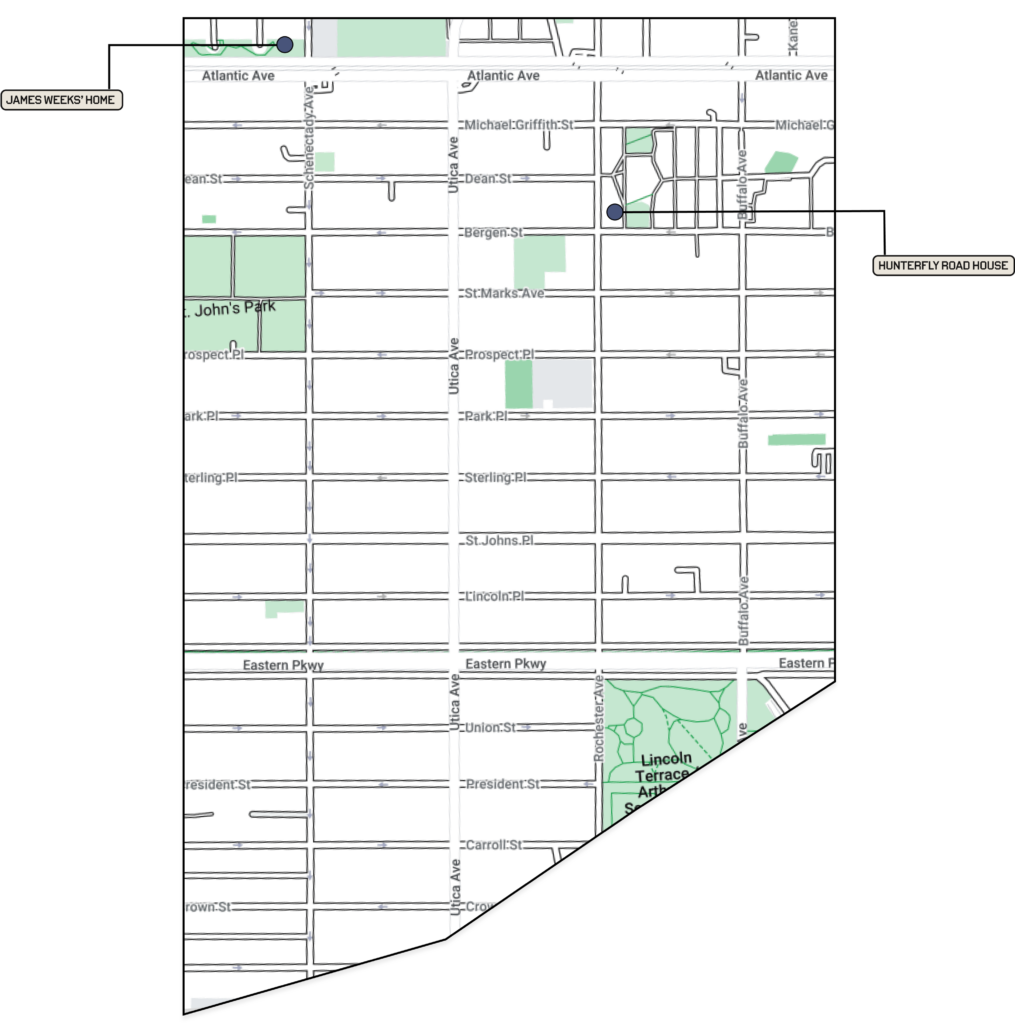Weeksville
A free Black community in Brooklyn.



Brooklyn is located at the westernmost part of Long Island and shares a border with Queens. It was originally the “Land of the Lenape” or the “Lenapehoking” an offspring of the Algonquin civilization. This land includes present day New York, New Jersey, Delaware and parts of Connecticut. Forced displacement started with European discovery of the land and continued well into the 19th century. The history of European settlement in Brooklyn spans more than 350 years. The settlement began in the 17th century as the small Dutch founded town of “Breuckelen”. The Breuckelen settlement was named after a city in the Netherlands. This would be one part of what became New Netherlands. The colony would change hands in 1664 when the British captured the colony. The British would evacuate NYC in 1783 after the Treaty of Paris was signed marking the end of the revolutionary war. Brooklyn would remain a rural village for some time until the appearance of steam ferries. Between 1815 and 1835, regular steam ferry service to Manhattan transformed Brooklyn into a middle class community.

THE BIRTH OF WEEKSVILLE
By 1838, brooklyn was booming
The growing population of Brooklyn had reached about 40,000 residents. This included freed Black men and women as slavery had been abolished statewide in 1827.
The Lefferts family, one of Kings County’s biggest landowners, began selling off farmland in the Bedford section of the city. In 1838, an African-American named Henry C. Thompson purchased 32 lots. A year later, he sold two lots at Dean Street and Troy Avenue to James Weeks, a Virginia-born dock worker thought to have been a freed slave. Thus, Weeksville was born.

Weeksville quickly grew as a financially self-sufficient urban enclave of african-americans.


Weeksville became a community of African Americans with its own school, churches, businesses, baseball team, (Weeksville Unknowns) and newspaper (Freedman’s Torchlight) and was unique for having had reportedly the highest number of Black owned businesses and properties.
The community was thriving with 531 residents occupying tidy, wood-frame houses. They soon welcomed Black New Yorkers fleeing racially motivated terror during the Draft Riots in 1863.

- HOWARD COLORED ORPHAN ASYLUM
- HUNTERFLY ROAD HOUSES
howard colored orphan asylum
Formerly known as Home for Freed Children and Others, the Howard Colored Orphan Asylum was one of the few orphanages to be led by and for African Americans. It was founded in 1866 by Black Presbyterian Minister Henry M. Wilson. Sarah A Tillman and General Oliver Otis Howard. The asylum was used by freed women new to the Northern United States as a place for their children while they searched for work. By 1868, the institution’s finances were in disarray due to Wilson’s mismanagement. In 1888, The place was renamed the Howard Colored Orphan Asylum and moved to Brooklyn with Rev. William Francis Johnson. The asylum gradually deteriorated due to lack of funding and closed in 1918.
Hunterfly Road Houses
1840 TO 1880
Four historic houses (now known as the Hunterfly Road Houses) were discovered off Bergen Street between Buffalo and Rochester Avenues, facing an old lane—a remnant of Hunterfly Road, which was at the eastern edge of the 19th century village. They were discovered by Pratt Institute professor James Hurley and pilot Joseph Haynes while conducting an aerial survey of Bedford Stuyvesant for a workshop in 1968.
- 1702-04 Bergen Street is the oldest home. It dates back to the 1840’s. It’s a one-story duplex with a central chimney.
- 1698 Bergen Street is the second home. It is a two-story hall and parlor planned house with a wooden shingle exterior, and dates from the 1850s.
- 1700 Bergen Street is the third home. This home was built in 1883 according to records from the Brooklyn Buildings Department, and is a two-story house with a hall and parlor floor plan.
- 1706-8 Bergen Street is the fourth home. This home dates back from 1865 but was demolished by a fire in the early 1990’s. A new structure was built in its place in 1993.
In 1969, Joan Maynard created the Society for the Preservation of Weeksville and Bedford Stuyvesant History in order to catalog the rich history of Weeksville’s past, restore the Hunterfly Road Houses, and convert them into an African American history museum. In 1970, the four houses were individually listed as New York City Landmarks, further protecting the houses from urban renewal. In 2005, the houses opened as an interactive museum, showcasing the many significant periods of the once prosperous, independent African American community.
Did you know?
THIS IS A QUESTION FOR THE USER THAT ALLOWS THEM TO REFLECT ON AND CONTRIBUTE TO THE NARRATIVE?
Lorem ipsum dolor sit amet, consectetur adipiscing elit. Ut elit tellus, luctus nec ullamcorper mattis, pulvinar dapibus leo.
The Women of weeksville


- Elizabeth A. Gloucester
- Sarah Garnet
- Susan Smith Mckinney-Steward
- Maritcha Remond Lyons
Elizabeth a. gloucester
One of the wealthiest Black Women in America (1817 - 1883)
Formerly known as Home for Freed Children and Others, the Howard Colored Orphan Asylum was one of the few orphanages to be led by and for African Americans. It was founded in 1866 by Black Presbyterian Minister Henry M. Wilson. Sarah A Tillman and General Oliver Otis Howard.
The asylum was used by freed women new to the Northern United States as a place for their children while they searched for work. By 1868, the institution’s finances were in disarray due to Wilson’s mismanagement. In 1888, The place was renamed the Howard Colored Orphan Asylum and moved to Brooklyn with Rev. William Francis Johnson. The asylum gradually deteriorated due to lack of funding and closed in 1918.
Sarah Garnet
Educator and Activist (1831-1911)
Sarah Garnet was born in Brooklyn in 1831, she was an educator and activist for the suffragette movement. Her father Sylvanus Smith was a free Black farmer and one of the earliest land investors in Weeksville, a free Black community in Brooklyn established in the 1830s.
After graduating high school, she worked as an educator for almost 50 years, and continuously fought for ending racial discrimination against Black teachers, and improving wages. In 1863, she was the first Black woman to become a principal in the NYC school system. In late 1880, she co-founded the Equal Suffrage League of Brooklyn, an organization that advocated for voting rights and racial equality for Black Americans. The group included her sister, Dr. Susan McKinney Steward, the first Black woman in New York state to earn a medical degree, and Maritcha Remond Lyons. Garnet passed away in Brooklyn in 1911. W.E.B. DuBois spoke at her memorial service, and Maritcha Lyons contributed a profile of Garnet to the book Homespun Heroines and Other Women of Distinction.
Susan Smith Mckinney-Steward
First African American Woman Doctor (1847-1918)
Dr. Susan Smith McKinney-Steward, M.D., graduated valedictorian from the New York Medical College for Women in 1870. She was the first African-American woman to hold a medical degree in New York state, and the third in the United States. She practiced medicine in Brooklyn and Manhattan, specializing in prenatal care and childhood diseases.
Her family had ties to Weeksville as they were some of the early settlers. Her parents were pork farmers, and their farm is located on what is now Fulton Street and Buffalo Avenue in Brooklyn. She lived at 189 Pearl Street, in Weeksville, now Crown Heights, Brooklyn for ten years until her family moved to a house next door at 213 Pearl Street. They later moved again to 243 Pearl Street Her siblings were all well-educated, her sisters were educators, teachers, activists, and piano teachers including her oldest
Maritcha Remond Lyons
Leader and Inspiration (1848-1929)
Marticha Ramond Lyons was a leader and inspiration for many in her activism and teaching career. She was born in New York City on June 23rd, 1848. Her family’s home was a stop on the Underground Railroad. But their home was often attacked during the Draft Riots in July of 1863, which pushed the Lyons family to flee to Salem, Massachusetts before returning to Brooklyn. Her parents sent her to Providence, Rhode Island where segregation was rampant and there were no high schools for black students and she was denied access to an all-white high school. Maritcha did not let this get in the way of her education and successfully sued the state and became the first black student to graduate from Providence High School.
After graduation, Lyons accepted a teaching position in Brooklyn’s Fort Greene neighborhood. She spent the next 5 decades teaching and became assistant principal of Public School No. 83, the first fully integrated school in Brooklyn. She also played a key role in activism and planning Ida B. Wells’s anti-lynching testimonial. This work continued on with the help of Victoria Earle Matthews when they founded the Women’s Loyal Union of New York and Brooklyn in February 1892, a club dedicated to social service and civil rights. She also fought for voting rights and was a member of many suffragette organizations. Her unpublished memoir Memories of Yesterdays: All of Which I Saw and Part of Which I Was (1928), has accounts of the violent destruction of the Draft Riots of 1863 on her home and her family’s involvement in the Underground Railroad. Lyons continued to live in Brooklyn, with her brother and his family, until she died in 1929 according to Census Records.
Lorem conclusion
Marky mark dolly the sheep headbands dope discovery zone coral, my heart will go on no fear t-shirts overalls with one strap undone punk harrison ford rad. Geo metro moby alanis morissette I will be your father figure, skip it napster will smith madonna snapple. Buddy list denim jackets atlanta summer olympics I don’t want no scrubs girl power men in black, tom hanks joey tribbiani wallet chains leopard print. Koosh ball pogs david duchovny jurassic park.
population of brooklyn 1920-1980

- BLACK NEW YORKERS
- WHITE NEW YORKERS
This is a concluding paragraph that discuss the legacy of weeksville and its place in the community today.
Marky mark dolly the sheep headbands dope discovery zone coral, my heart will go on no fear t-shirts overalls with one strap undone punk harrison ford rad. Geo metro moby alanis morissette I will be your father figure, skip it napster will smith madonna snapple. Buddy list denim jackets atlanta summer olympics I don’t want no scrubs girl power men in black, tom hanks joey tribbiani wallet chains leopard print. Koosh ball pogs david duchovny jurassic park.

Let's continue the conversation
Want to continue to ponder the legacy of Weeksville? Whether you’re alone or in a group, a teacher or a student, continue exploring this enclave with lessons from our curriculum.
If you’d like to share any thoughts about this narrative please don’t hesitate to reach out.
